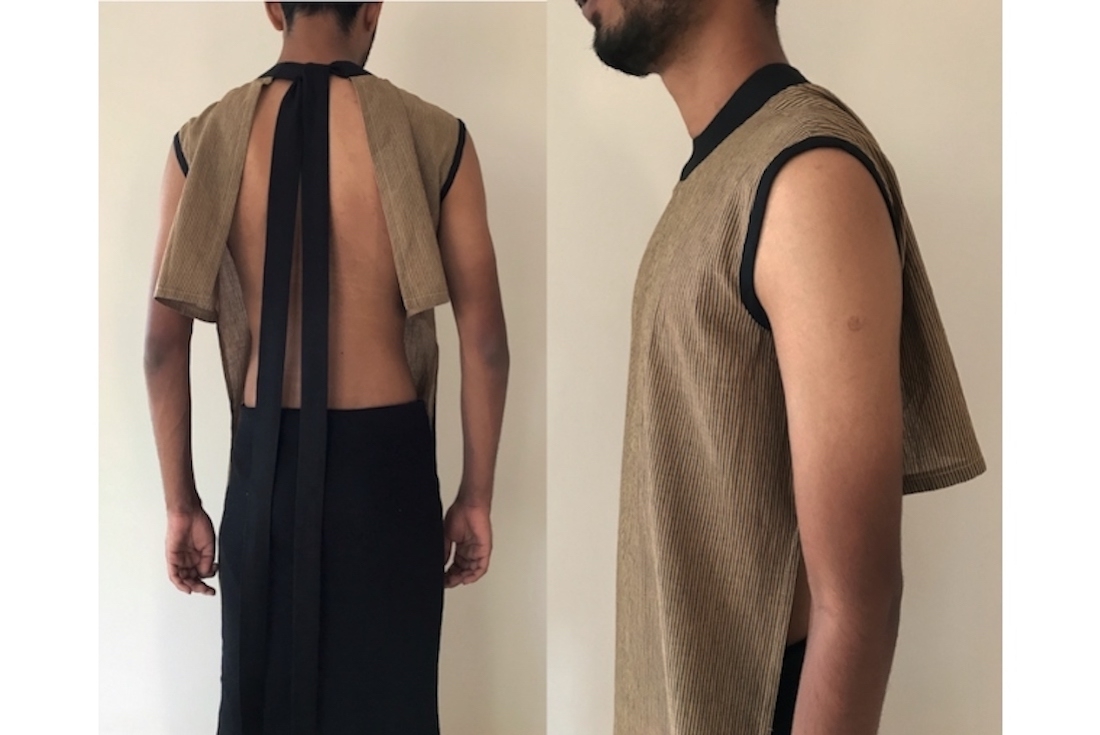
Half, Open Back Tunic with Bands as Ties, 2020. Repurposed surplus Bt cotton fabric and repurposed cotton silk fabric.

Half, Open Back Tunic with Bands as Ties, 2020. Repurposed surplus Bt cotton fabric and repurposed cotton silk fabric.
It was at an early age that multidisciplinary artist Rujuta Rao fostered a strong sense of discipline in creating her art. ‘This discipline was not imposed on me, but stemmed from a need to make art. As a child growing up in Goa, I developed a studio practice unknowingly. This practice continued through my BFA in sculpture at Maharaja Sayajirao University of Baroda, my MFA in interdisciplinary art at Parsons School of Design in New York City and has still sustained,’ she adds.
Currently invested in studying Otto Von Busch’s research on hacktivism, a form of activism which works towards the democratization of fashion, Rujuta is mulling over his work on transforming fashion into a collective and participatory experience, leading to empowerment and liberation from the present monopoly of certain brands. The writing and work of curator and exhibition maker Judith Clark, especially Clark’s work with fashion, has also influenced the way she thinks about the presentation of garments. Rujuta has been learning about Somatic Experiencing as well, a therapy aimed at alleviating mental and physical trauma by placing emphasis on perceived bodily sensations. This learning, especially through the works of Peter Levine and Bessel van der Kolk, informs her texts, garments, objects and the scores she writes for performances. The writings and works of Hito Streyerl and Harun Farocki have influenced her thinking greatly, and continue to do so.

Half-back Tunic and a Gridded Sleeve, 2020. Surplus handspun and handwoven Bt cotton fabric with plastic buttons, natural dyed organic cotton with a plastic buckle.
An extension of Rujuta’s artistic practice is her endeavour, RAO, a platform for the non-binary garments, carefully constructed by either repurposing old clothes using surplus fabric from upholstery shops in Goa, and natural dyed cotton or organic cotton. The artist’s intention behind these garments is to generate a discourse about the age old notions of size, inhibition and gender. She describes her garments as, ‘a negotiation between risk and safety, familiarity and strangeness, the well-fitted and the oddly-fitted, the intimate and the clinical, covering and exposure, comfort and shame.' The garments have a lot more hidden between their seams and stitches than visible to the naked eye. She further explains, ‘The choice of fabric, form and method, such as repurposing old garments, is informed by my study of Indian textiles and my research on the life cycle of the garment — from the production of raw material to its disposal. I am now focused on the urban Indian sartorial dilemma of what to wear — as a negotiation between the traditional and the modern — best elucidated in the work of British anthropologist Emma Tarlo. The objects I make, including the garments, come together in the form of participatory installations which are flat-packable, shape-shifting and mobile. At different points of the exhibition, the installation functions as a workshop, a studio or a gallery.'
What completes it all further is her presence in the space, facilitating a tactile engagement between the audience and her objects. As a facilitator she ensures the environment remains dynamic — objects are rearranged and photographs are inserted in the garments amongst other things. The photographs are signifiers of animistic objects and the documentation of these garments is as vital as the garments themselves. Essentially, her art helps develop a sense of intimacy, one that is very visible in all the dynamic installations wherein the objects act as mediators between her and the audience.
Rujuta’s practice involves building fictional narratives, by extending technological processes to the female body and mind, thereby articulating the fragmenting effects of trauma on the bodies, minds and memories of women. For instance, she looks at ‘defragging’ through the lens of psychoanalysis and extends it to the female body image. Her narratives take the form of text, sound pieces, gifs, and sculptural objects. The artist doesn’t stick to one medium in particular, but engages in free play depending upon what that particular work requires
At a time like this pandemic, with limited resources and materials either unavailable or inaccessible, Rujuta is finding new ways and mediums to work with. She recently began working on STUDIO TIME, a platform she co-created with artist Alejandro Yoshii. STUDIO TIME is a virtually shared studio time for two hours each week, which can be joined by anyone anywhere. People can start or join conversations, share their work, or simply work in silence in the company of others. The basic intent behind STUDIO TIME was to overcome the isolation of a studio practice, especially during the lockdown when studio visits aren’t possible.
Rujuta now divides her time between India and the United States. She is presently working on a performance with objects, which looks into the history of cocktails and spirits. She is also working on a series of interviews with people who work with cocktails, spirits, beer, food and more.
To follow the artist, find her on Instagram and https://www.rujutarao.com.
Text Unnati Saini